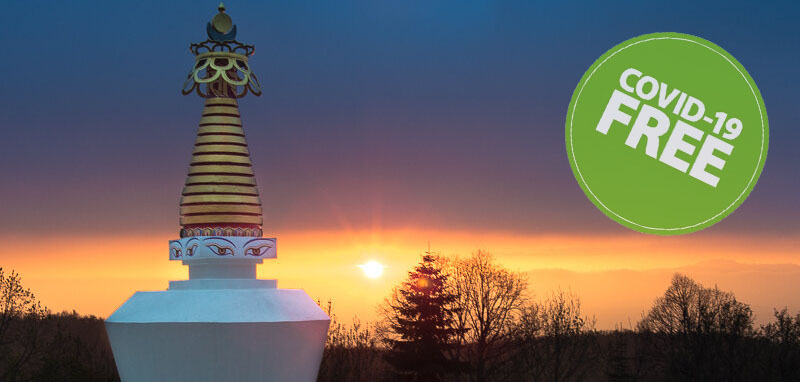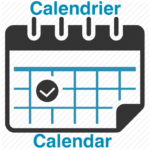Retraite de 100 Nyoung Né en 2022
Nous sommes heureux d’annoncer que Karma Migyur Ling va reprendre en 2022 la retraite de 100 Nyoung Né. Elle débutera le 22 octobre et terminera début mai 2023. Elle sera dirigée par Lama Sangpo, dans le nouveau temple de Nyoung Né. Celui-ci est pratiquement terminé. Il sera aménagé et décoré dans les prochains mois de manière traditionnelle par un artiste tibétain, Tenpa Rabgyé qui a déjà réalisé de nombreuses peintures à Montchardon. L’autel est en cours de réalisation par notre ami Samten, notre menuisier maison et sera achevé au cours de cet hiver ou du printemps prochain.
Nous annonçons dès maintenant ce projet afin que ceux qui veulent faire la retraite puissent être informés et s’y préparer dès maintenant.
Lors de prochaines nouvelles, nous pourrons préciser les détails de cette retraite (prix, conditions de séjour, logement, …). Nous en reparlerons.
Ceux qui sont intéressés par cette retraite sont priés de le faire savoir à l’accueil de manière à anticiper cette organisation.
Qu’est-ce que la pratique de Nyoung Né ?
Petit rappel pour ceux qui ne sont pas familiers avec cette pratique : considérée comme une des pratiques les plus puissantes en termes de bienfaits, aussi bien pour les vivants que les personnes défuntes, elle est liée à l’aspect de Tchenrézi à onze visages et mille bras, personnification de l’amour et la compassion de tous les Bouddhas. Traditionnellement, cette pratique est tenue en haute estime par nos maîtres, car elle est relativement accessible, représente un moyen puissant de purification et amène de très grands bienfaits. En effet, elle rassemble la totalité des aspects du Dharma, selon les trois Véhicules. Selon le Véhicule de « Libération individuelle » (Hinayana), le pratiquant de Nyoung Né s’engage à l’observance des vœux de conduite éthique, les vœux de Sodjong. Les laïcs peuvent ainsi s’entraîner à la conduite éthique sur de courtes durées. Le cœur de la pratique est ancré dans le Grand Véhicule (Mahayana), par le développement de l’esprit d’éveil, l’amour, la compassion, l’aspiration à aider tous les êtres. Enfin, elle met en œuvre les moyens du Vajrayana par l’utilisation des visualisations, de récitations de mantras, du développement de l’expérience méditative (samadhi).
Lama Teunsang a toujours insisté sur les mérites d’une pratique en groupe, car en plus des bienfaits des interactions relationnelles, les mérites des pratiques sont d’autant plus grands qu’il y a de pratiquants au sein du mandala.
La Retraite de 100 Nyoung Né
Lama Teunsang a toujours accordé une immense importance à cette pratique et l’a adoptée comme l’une des pratiques principales de Karma Migyur Ling. Organisée chaque année depuis 1982, c’est devenu une spécificité de Montchardon.
La première retraite de 100 Nyoung Né à eu lieu en 1988, dirigée par Lama Teunsang durant 7 mois d’affilée. Cette retraite s’est poursuivie ainsi chaque année durant trente ans. Ainsi, au fil des années, un total de 35 000 Nyoung Né ont été accomplis, auxquels ont participé des milliers de personnes, ce qui est considérable et peu courant, même dans le monde tibétain.
Cette retraite des 100 Nyoung Né a été temporairement interrompue en 2017 du fait d’une diminution du nombre de participants pour l’ensemble de la pratique. Lama Teunsang a souhaité faire une pause durant quelques années, en remplaçant cette longue retraite par des sessions plus courtes sous forme de 8 Nyoung Né consécutifs, trois fois par an. Néanmoins, ces retraites de 100 Nyoung Né devaient reprendre dès lors que cinq à sept participants s’engageraient à faire la totalité de la retraite.
Lama Teunsang a toujours souhaité établir cette pratique de façon régulière et pérenne et l’implanter sur le sol de Montchardon pour qu’elle puisse continuer à être accomplie par les générations futures. Dans cette perspective, il a souhaité aménager un nouveau temple dévolu à cette pratique, plus grand et fonctionnel que l’actuel temple des Nyoung Né qui, bien que fort attachant, est devenu trop petit et est d’un accès difficile pour le public.
C’est maintenant chose faite. Le nouveau temple qui prend place dans le bâtiment actuellement en construction sera disponible courant 2022.
A plusieurs reprises, Lama Teunsang a émis le souhait de diriger une nouvelle retraite de 100 Nyoung Né lorsque ce nouveau temple sera terminé. Mais sa santé ne lui permettant pas d’accomplir ce souhait, c’est Lama Sangpo qui prendra sa relève pour diriger cette nouvelle retraite. A l’avenir, cette pratique pourra être dirigée par les autres lamas de Montchardon.
Concrètement, comment se déroule un Nyoung Né ?
Un Nyoung-Né se passe sur 48 heures, débute le matin du 1er jour à l’aube et se termine le 3ème jour au matin, à 9h. On accomplit chaque jour trois fois le rituel en observant le jeûne et le silence, partiel lors du 1er jour, appelé Nyé-Né, et totalement le 2ème jour. Les personnes qui sont dans l’impossibilité d’observer le jeûne total du 2ème jour, peuvent faire ”Nyé-Né”, le jeûne partiel, en prenant un repas à midi.
En quoi consiste cette retraite ?
Cette retraite consiste en une succession de cette pratique de 48 heures, qui s’enchaine en continu sur 200 jours. Certaines personnes vont s’engager sur la totalité des sept mois.
Mais cette retraite est également ouverte à ceux qui veulent y participer partiellement. Ainsi, il est possible de s’y joindre à tout moment pour un Nyoung Né ou pour plusieurs, voire sur une période plus longue, quelques semaines ou des mois, selon ses possibilités.
100 Nyung Ne retreat in 2022
We are pleased to announce that Karma Migyur Ling will resume the 100 Nyung Ne retreat in 2022. It will start on 22 October and end in early May 2023. It will be led by Lama Sangpo in the new Nyung Ne temple. The temple is almost finished. It will be fitted out and decorated in the next few months in the traditional way by a Tibetan artist, Tenpa Rabgyé, who has already done many paintings in Montchardon. The altar is being made by our friend Samten, our in-house carpenter, and will be completed during this winter or next spring.
We are announcing this project now so that those who want to make the retreat can be informed and prepare for it now.
In future newsletters, we will be able to give more details about the retreat (price, conditions of stay, accommodation, …). We will talk about it again.
Those who are interested in this retreat are asked to let us know at the reception desk so that we can anticipate this organisation.
What is the practice of Nyoung Né?
A quick reminder for those who are not familiar with this practice: considered to be one of the most powerful practices in terms of benefits for both the living and the deceased, it is linked to the aspect of Chenrezi with eleven faces and a thousand arms, the personification of the love and compassion of all Buddhas. Traditionally, this practice is held in high esteem by our masters because it is relatively accessible, represents a powerful means of purification and brings great benefits. Indeed, it brings together all aspects of the Dharma, according to the three Vehicles. According to the Vehicle of « Individual Liberation » (Hinayana), the practitioner of Nyung Ne commits to the observance of the vows of ethical conduct, the Sodjong vows. Lay people can thus train in ethical conduct for short periods of time. The heart of the practice is rooted in the Great Vehicle (Mahayana), through the development of the mind of awakening, love, compassion, the aspiration to help all beings. Finally, it implements the means of the Vajrayana through the use of visualisations, mantra recitations and the development of meditative experience (samadhi).
Lama Teunsang has always emphasised the merits of group practice, for in addition to the benefits of relational interaction, the merits of the practices are greater the more practitioners there are within the mandala.
The 100 Nyung Ne Retreat
Lama Teunsang has always attached great importance to this practice and has adopted it as one of the main practices of Karma Migyur Ling. Organised annually since 1982, it has become a special feature of Montchardon.
The first retreat of 100 Nyung Ne took place in 1988, led by Lama Teunsang for seven months in a row. This retreat has continued every year for thirty years. Thus, over the years, a total of 35,000 Nyung Nis have been performed, attended by thousands of people, which is considerable and unusual even in the Tibetan world.
This 100 Nyung Ne retreat was temporarily interrupted in 2017 due to a decrease in the number of participants for the entire practice. Lama Teunsang wished to take a break for a few years, replacing this long retreat with shorter sessions in the form of 8 consecutive Nyung Ne, three times a year. However, these 100 Nyung Ne retreats were to be resumed as soon as five to seven participants committed to doing the whole retreat.
Lama Teunsang has always wished to establish this practice on a regular and permanent basis and to implant it on the soil of Montchardon so that it can continue to be performed by future generations. In this perspective, he wished to build a new temple dedicated to this practice, larger and more functional than the current Nyoung Né temple which, although very attractive, has become too small and is difficult to access for the public.
This is now a reality. The new temple in the building currently under construction will be available in 2022.
On several occasions, Lama Teunsang has expressed the wish to lead a new retreat of 100 Nyung Ne when the new temple is completed. However, his health does not allow him to fulfil this wish, so Lama Sangpo will take over the leadership of this new retreat. In the future, this practice can be led by the other lamas of Montchardon.
How does a Nyung Ne take place in practice?
A Nyoung-Né takes place over 48 hours, starting on the morning of the first day at dawn and ending on the third day at 9am. The ritual is performed three times a day, observing fasting and silence, partially on the first day, called Nyoung Ne, and completely on the second day. Those who are unable to observe the total fast on the second day may Translated with www.DeepL.com/Translator (free version)




